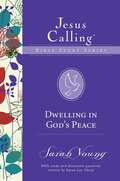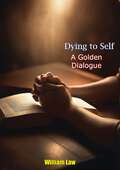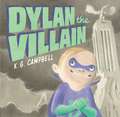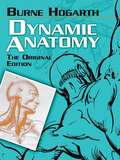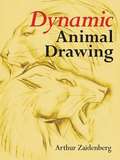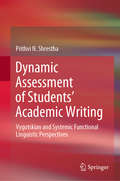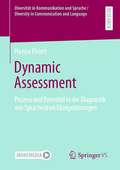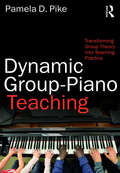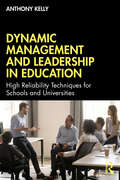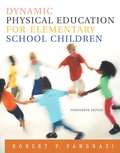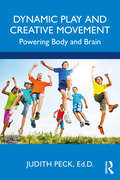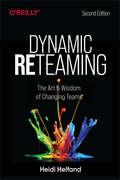- Table View
- List View
Dwelling in God's Peace (Jesus Calling Bible Studies)
by Sarah YoungIn Dwelling in God's Peace, the seventh study in the Jesus Calling Bible Study Series, you will explore what the Bible says about the peace that God offers when you trust in Christ and rely on the Holy Spirit's work in your life. This peace, which "surpasses all understanding" (Philippians 4:7), allows you to trust the Lord in any situation and believe He will always take care of you. As you experience this peace, you come to recognize the blessings you have been given–and be thankful for them regardless of what you are facing. Each of the Jesus Calling Bible studies includes devotional readings from Jesus Calling, selected passages of Scripture for reflection, Bible study questions, and additional questions to help you apply the material. This study can be used for personal reflection and Bible study or in a small-group setting.
Dying for Victorian Medicine
by Elizabeth T. HurrenIn the nineteenth century the business of anatomy was very profitable. However, existing in a Victorian underworld, its shadowy details and potential links to the Jack-the-Ripper murders were seldom exposed. In this accessible and vibrant account, Elizabeth Hurren brings to life lost pauper stories recovered from the asylums, infirmaries, workhouses, body dealers, railway men and undertakers that supplied the medical profession with dissection subjects. The details of those trading networks, corpse sales, body parts fees, railway transportation costs and funeral expenses have never been documented before now, yet this economy of supply in the dead underpinned modern medicine. In Dying for Victorian Medicine, Hurren allows us to look for the first time into the human face of abject poverty, working back in the archives from death to touch the lives of those compelled by pauperism to give up a loved one's body for dissection.
Dying to Self A Golden Dialogue: A Golden Dialogue (1898)
by William LawThis classic Christian book combines the work of two famous authors from the past: Andrew Murray (a famous South African preacher and writer born in the 1800s) and William Law (a priest from the Church of England born in the 1600s).In it, Andrew Murray provides commentary on the work of William Law which tackles a very difficult subject for many Christians: dying to self. First published in the 1800s, “Dying to Self” is one of Murray’s (and Law’s) lesser known works. Though written many years ago, Murray’s comments on Law’s insightful text have been “pure gold” to the hearts of numerous readers.The conversational style of the book between two people (Eusebius and Theophilus) seeking further enlightenment on the topic was written by Law, with explanations provided by Murray. Law’s wisdom, combined with Murray’s commentary, makes for an excellent treatment of the subject which will be especially helpful to Christians who don’t fully understand what “dying to self” really means. The good news, as Murray so expertly points out, is that this “dying to self” can and will be wrought by the Spirit of God when we surrender to Him. Fans of Murray’s book on Hebrews (“The Holiest of All”) will recognize that “Dying to Self” further clarifies Murray’s teachings as expounded in that book.-Print ed.
Dying, Bereavement and the Healing Arts
by Amy Kuebelbeck Julie Sanders Gillie Bolton Mike White Christopher Johns Nigel Hartley Ted Bowman Hilary Elfick Lindsay Buckell Lesley Schatzberger Mitzi Blennerhassett Ashley Barnes Christina Mason Steve Seagull Bobbie Farsides Anna Lidzey Filipa Pereira-Stubbs Kieran Walsh Judy Clinton Sinead Donnelly Sue Eckstein Monica Suswin Frans Meulenberg Oliver Samuel Kate D'Lima Robert Hamberger Corine Koppenol Paul Schatzberger Haifa Al Sanousi Yvonne Yi-Wood Mak Tim Metcalf Chris Rawlence Giles Legood Rogan Wolf River Wolton Sheelagh Gallagher Tim Jeeves Mark Cobb Kaichiro Tamba Sandra Bertman Diana Greenman John Graham-Pole David HeadDying, Bereavement and the Healing Arts describes a range of successful programmes pioneered by artists, writers, nurses, musicians, therapists, social workers, and chaplains in palliative care settings. These range from simple painting and writing activities to organized communal activities like writing and performing a play. The arts are shown to offer a means to reflect on memories, hopes, fears and anxieties, and gently explore the emotional, spiritual, and psychological issues which can aid a fuller understanding of oneself and one's condition. The arts also serve as a way to communicate difficult and complex feelings to professionals or family members not possible in everyday conversation. Dying, Bereavement and the Healing Arts offers valuable insights and inspiration for any practitioner working in a palliative care setting.
Dylan the Villain
by K. G. CampbellA surprising and laugh-out-loud showdown between two pint-sized super-villains, perfect for young fans of Despicable Me.Dylan's parents, Mr. and Mrs. Snivels, have always told him that he is the very best and cleverest super-villain in the whole wide world. And Dylan's confident that it's true--until he starts school and meets Addison Van Malice. Sure, Dylan's costume is scary. But Addison Van Malice's is bone-chilling. And yes, Dylan's laugh is crazy. But Addison Van Malice's is bananas. And Dylan's inventions are certainly super-villainous. But Addison Van Malice's are demonic! When their teacher, Ms. Ick, announces a Diabolical Robot Building Contest, Dylan sees his opportunity to prove that he really is the most evil villain of all. But Addison's not giving in without a fight. And so begins a competition of skill and wits that doesn't go the way anyone expected...
Dynamic Anatomy: The Original Edition
by Burne HogarthHailed by teachers, students, and critics for fifty years, this manual presents both action studies and practical diagrams for portraying the human figure in motion and at rest. Anatomical details appear in pragmatic, generalized shapes that simplify identification and reproduction. More than 300 images complement the easy-to-follow text, which includes a valuable survey of art history and magnificent figure drawings by such masters as Michelangelo, Rembrandt, Rodin, and Picasso.Burne Hogarth, called "the Michelangelo of the comic strip," is best known for his long-running Tarzan cartoons and for helping found New York's School of Visual Arts. In this study of the human figure, he explains muscular and skeletal structure from the artist's point of view, rather than that of the medical anatomist. Hogarth extends beyond the factual elements of anatomy to emphasize the relationship of mass to movement. His guide will prove an indispensable companion to artists at all skill levels who wish to render the human figure accurately and artistically.
Dynamic Animal Drawing
by Arthur ZaidenbergIn this step-by-step guide for beginning and intermediate artists, an expert teacher shows students how to see an animal in its simplest form and capture its essential character in a drawing. More than 500 illustrations demonstrate the depiction of familiar and exotic creatures--from dogs, cats, and birds to hippopotami, zebras, buffalo, and kangaroos. A noted painter, sculptor, and teacher, Arthur Zaidenberg based his techniques on the notion that anyone who can write the alphabet can combine simple shapes and draw. With his coaching, aspiring artists learn to look past the confusion of superficial details and discover an animal's distinguishing features. Preliminary and finished sketches accompany Zaidenberg's succinct, direct advice on recapturing the subtle strength of horses, the variety among canine breeds, the muscular grace of giraffes, the majesty of elephants, and other innate qualities of creatures from the animal kingdom.
Dynamic Assessment of Students’ Academic Writing: Vygotskian and Systemic Functional Linguistic Perspectives
by Prithvi N. ShresthaThis book explores the application of an innovative assessment approach known as Dynamic Assessment (DA) to academic writing assessment, as developed within the Vygotskian sociocultural theory of learning. DA blends instruction with assessment by targeting and further developing students’ Zone of Proximal Development (ZPD).The book presents the application of DA to assessing academic writing by developing a set of DA procedures for academic writing teachers. It further demonstrates the application of Hallidayan Systemic Functional Linguistics (SFL), combined with DA, to track undergraduate business management students’ academic writing and conceptual development in distance education.This work extends previous DA studies in three key ways: i) it explicitly focuses on the construction of a macrogenre (whole text) as opposed to investigations of decontextualized language fragments, ii) it offers the first in-depth application of the powerful SFL tool to analyse students’ academic writing to track their academic writing trajectory in DA research, and iii) it identifies a range of mediational strategies and consequently expands Poehner’s (2005) framework of mediation typologies. Dynamic Assessment of Students’ Academic Writing will be of great value to academic writing researchers and teachers, language assessment researchers and postgraduate students interested in academic writing, alternative assessment and formative feedback in higher education.
Dynamic Assessment: Prozess und Potential in der Diagnostik von Sprachentwicklungsstörungen (Diversität in Kommunikation und Sprache / Diversity in Communication and Language)
by Hanna EhlertIn dieser Publikation wird Dynamic Assessment erstmalig im deutschsprachigen Raum zur Sprachdiagnostik mehrsprachiger Kinder im Kindergartenalter in einer Studie pilotiert. Dynamic Assessment ist eine alternative diagnostische Vorgehensweise im Bereich Kindersprache. Sie hat Potential, die tatsächlichen sprachlichen Kompetenzen bisher schwer zu diagnostizierenden Zielgruppen, wie mehrsprachige Kinder, zu erfassen. Durch ihren Fokus auf die situativen sprachlichen Lernfähigkeiten unterscheidet sie sich mit einem in die Zukunft gerichteten Blick von klassischen Diagnostikansätzen, welche lediglich den Status Quo sprachlicher Leistungen erfassen.
Dynamic Ecologies
by Neil Murray Angela ScarinoThis volume provides a fascinating glimpse into the complex language ecologies of Southeast Asia. Adopting a relational perspective, it considers their significance for the region, its peoples, the policy and practice of language teaching, learning and assessment and the fate of local languages. It gives particular prominence to the relationship between English and Chinese, it's likely transformation at a time of significant global change and the impact that these two languages and their synergy will have on the place of other languages and dialects. Dynamic Ecologies: A Relational Perspective on Languages Education in the Asia-Pacific Region draws on the research and insights of key scholars in the field and provides case studies that illustrate the impact of relevant language policy in countries including Singapore, Malaysia, Hong Kong, South Korea and Australia.
Dynamic Group-Piano Teaching: Transforming Group Theory into Teaching Practice
by Pamela PikeDynamic Group-Piano Teaching provides future teachers of group piano with an extensive framework of concepts upon which effective and dynamic teaching strategies can be explored and developed. Within fifteen chapters, it encompasses learning theory, group process, and group dynamics within the context of group-piano instruction. This book encourages teachers to transfer learning and group dynamics theory into classroom practice. As a piano pedagogy textbook, supplement for pedagogy classes, or resource for graduate teaching assistants and professional piano teachers, the book examines learning theory, student needs, assessment, and specific issues for the group-piano instructor.
Dynamic Learning Spaces in Education
by Veena Kapur Sudipta GhoseThis volume discusses the need for a major paradigm shift in educational practice in the current digital and globalized world. It establishes a bridge between theory and praxis and revisits the objectives of learning and its modalities within the context of a rapidly evolving global world order. This volume includes perspectives from different countries on creating a dynamic and adaptive education system that encourages creativity, leadership, flexibility, and working in virtual as well as inclusive environments. The four sections include chapters that discuss creating meaningful learning environments, preparing teachers for new age classrooms, the digital learning space, fostering change in classrooms, and importantly also includes cases and experiments from schools. The authors are teacher educators, teachers and researchers, and each chapter, while being deeply rooted in theory, is juxtaposed with informed practice, making the suggestions easy to implement in different settings. This is an important resource for researchers and practitioners associated with education systems in creating engaging, meaningful and future-ready education practices.
Dynamic Lecturing: Research-Based Strategies to Enhance Lecture Effectiveness
by Christine Harrington Todd D. ZakrajsekIs the lecture an outmoded teaching method that inhibits active learning or is it a potentially powerful tool that is an essential part of every teacher’s repertoire?This book presents up-to-date research on the different types of lecture, on what constitutes effective lecturing, and on the impact of lecturing when done appropriately and well. It fills the void in professional development resources on how to lecture, validating the practice when it’s aligned with the educational mission of creating engaged learning environments.Christine Harrington and Todd Zakrajsek demonstrate that, rather than lecture and active learning being mutually exclusive or either-or propositions, the effectiveness of the former can be greatly enhanced when combined with active learning techniques through what they define as dynamic lecturing; and provide context about the need to balance these approaches to meet the needs of students as they progress from novice to advanced learners.They present a range of strategies that enhance student learning during lectures. They open each chapter with the evidence behind each lecturing strategy they describe, and conclude with practical suggestions for quick application in the classroom. They offer readers the lecture planning and evaluation tools for reworking their lectures in ways that provide high-level engagement and achievement for their students. The opening section of the book explores the benefits of lecturing and describes the different modalities of lecture, with an assessment of the advantages and disadvantages of each. The second section focuses on educational strategies to enhance the lecture, including, among others, activating prior knowledge, emphasizing important points, effectively using multi-media, making concepts meaningful via examples, and the importance of retrieval practice. Each covers the underlying theory and research, and advice on how to align the engagement techniques with instructional goals. The book concludes with guidance on effective planning for lecturing and helping chairs, administrators, or peers engage in effective evaluation of the lecture.This is a dynamic resource for all faculty interested in revitalizing their teaching. The strategies are succinct, easy to incorporate into lectures and, done well, will have immediate impact and increase student mastery of course content.
Dynamic Management and Leadership in Education: High Reliability Techniques for Schools and Universities
by Anthony KellyThis book presents a new integrated theory of dynamic management and leadership in one comprehensive approach. It offers a new way of looking at the field, drawing on a wide body of research and practice in the fields of leadership and management, across all sectors in education and more broadly. The book focuses on management against a backdrop of leadership theory. Including examples of practice and application in schools, colleges and universities, it uses a range of historical leadership approaches to scaffold different management techniques that are known to work in effective organisations. It explores the overlap between management and leadership as dynamic theoretical and practical activities, merging the two together into a holistic model that can be applied by managers working in educational settings. Its twenty-six chapters also consider the praxis of educational leadership and management from political, economic and ethical perspectives in relation to issues such as equity and widening participation, and outline how ‘managership’ impacts on student achievement. Offering a unique balance of theory and practice, across school, college and university sectors, the book will be of great interest to researchers, academics, graduate students and practitioners in the field of educational leadership and management, and will be important reading for all stakeholders in the area of educational effectiveness and improvement.
Dynamic Perspectives on Creativity: New Directions For Theory, Research, And Practice In Education (Creativity Theory and Action in Education #4)
by Ronald A. Beghetto Giovanni Emanuele CorazzaThis edited volume provides a venue for scholars whose work challenges the typical, static conceptions, and methods of studying creativity. More specifically, the book will serve as an effort to introduce more dynamic definitions, conceptions, and approaches for studying creativity in the context of educational practice. By doing so, it feeds the strong contemporary need for more dynamic conceptions of creativity in educational settings. This is particularly important given the fast evolution of modern society and the widespread consensus that efforts to develop creative potential should be democratized -- extending well beyond the boundaries of the gifted subset and the walls of the classroom. This work recognizes that more dynamic perspectives on creativity are necessary for understanding its complexity, value, and meaning in educational contexts.
Dynamic Perspectives on Managerial Decision Making
by Herbert Dawid Karl F. Doerner Gustav Feichtinger Peter M. Kort Andrea SeidlThis volume collects research papers addressing topical issues in economics and management with a particular focus on dynamic models which allow to analyze and foster the decision making of firms in dynamic complex environments. The scope of the contributions ranges from daily operational challenges firms face to strategic choices in dynamic industry environments and the analysis of optimal growth paths. The volume also highlights recent methodological developments in the areas of dynamic optimization, dynamic games and meta-heuristics, which help to improve our understanding of (optimal) decision making in a fast evolving economy.
Dynamic Physical Education for Elementary School Children
by Robert P. Pangrazi Aaron BeighleDynamic Physical Education for Elementary School Children (DPE) is the longest-running elementary methods textbook on the market, and this latest edition is just as pertinent, essential, and cutting-edge as ever. DPE does more than provide the foundational knowledge needed to teach quality physical education—it applies this knowledge with an array of physical activities that equip preservice physical educators to teach with confidence from their first day. Now, for the first time, the text is made even more practical with the free interactive website Dynamic PE ASAP, which replaces the previous print resource Dynamic Physical Education Curriculum Guide: Lesson Plans for Implementation. With the Dynamic PE ASAP site, teachers have access to ready-to-use activities and complete lesson plans, as well as the ability to build their own lesson plans from the provided activities. This resource puts a complete curriculum for quality physical education at teachers’ fingertips. DPE also offers practical teaching tips, case studies of real-life situations to spark discussion, and instructor resources (an instructor guide, presentation package, and test package) that will make preparing for and teaching a course a breeze.
Dynamic Physical Education for Elementary School Children (fourteenth edition)
by Robert P. PangraziIncludes directions for protecting students from injury, how to play such games as soccer, and seemingly everything a teacher would need to design and implement a successful and appropriate PE program for young students.
Dynamic Play and Creative Movement: Powering Body and Brain
by Judith PeckDynamic Play and Creative Movement offers effective and accessible methods to supplement elementary education for young children using dance, movement, and play. Imagination, physical energy, and the need for self-expression are childhood qualities recognized by parents but are not sufficiently valued to be applied to formal education. Yet when valued as natural endowments, they might intelligently be used to increase a child's perceptive abilities and self-confidence, essential to learning. These three qualities combine in dynamic play, a term devised by the author to describe an approach to learning. Through physical participation, children deal with concepts, ideas, and emotions while they reach out to touch a vast world of people, animals, nature, and activities. The chapters provide for improvisations in music, visual art, drama and stories in addition to topics related to the changing seasons, sports, school subjects, travel, games, and many other elements of the natural and man-made world. Research about the correlation of movement to brain activity is included to support the thesis that creative movement is an effective adjunct to learning. Therapists, counselors, and preschool and elementary teachers will find this easily adaptable material valuable in fostering perception, insight, and cognitive understanding in children.
Dynamic Posing Guide
by Jeanne Harris Craig StidhamTips, techniques, and inspiration for creating perfect posesEffectively posing the human body is a challenge for nearly every photographer, from amateur to professional. Understanding how a model's pose, body language, and posture affect a photograph is crucial to success. Author and professional fashion photographer Craig Stidham shows you how to guide a subject's personality through body language, with hundreds of examples and suggestions. Answers critical questions such as: how can a photographer avoid having the subject look awkward? How does one direct both experienced and inexperienced models?Shares helpful posing tips and techniques for posing models in new modern and fashion-forward waysSuggests ways to make strategic edits in post-production to fix common posing mistakes Offers hundreds of examples of strong and stunning posingDynamic Posing Guide teaches you the skills you need to identify strong modern posing techniques as you strengthen your photographic skills.
Dynamic Reteaming: The Art and Wisdom of Changing Teams
by Heidi HelfandYour team will change whether you like it or not. People will come and go. Your company might double in size or even be acquired. In this practical book, author Heidi Helfand shares techniques for reteaming effectively. Engineering leaders will learn how to catalyze team change to reduce the risk of attrition, learning and career stagnation, and the development of knowledge silos.Based on research into well-known software companies, the patterns in this book help CTOs and team managers effectively integrate new hires into an existing team, manage a team that has lost members, or deal with unexpected change. You’ll learn how to isolate teams for focused innovation, rotate team members for knowledge sharing, break through organizational apathy, and more.You’ll explore:Real-world examples that demonstrate why and how organizations reteamFive reteaming patterns: One by One, Grow and Split, Isolation, Merging, and SwitchingTactics to help you master dynamic reteaming in your companyStories that demonstrate problems caused by reteaming anti-patterns
Dynamic Seascapes: How to Paint Seas and Skies with Drama and Energy
by Judith YatesArtists wishing to capture the excitement and power of the sea in their artwork will find this book invaluable. Judith Yates uses a mix of traditional and more experimental techniques to create her dynamic seascapes, all of which are explained in clear, step-by-step sequences, annotated examples and Judith's stunning artworks.With sections on colour, composition, and creating atmosphere, this book is a comprehensive approach to painting the tumultuous ocean with a mix of acrylics, watercolour and acrylic inks. Judith's varied, mixed media approach gives this book wide appeal to watercolour and acrylics artists looking to expand their creative horizons.This book demystifies all aspects of painting the sea, including details on the form and anatomy of a wave; bringing light, atmosphere and drama into the sky; and choosing colours to create a mood. It also provides a great source of inspiration to artists who are drawn to the sea as a subject for their own paintings.
Dynamic Social Studies
by George MaximPractical and dynamic are the hallmarks of the popular Dynamic Social Studies , and this new edition steps up its focus with a fresh design and a number of updates that give readers a clear vision of the most effective ways to teach social studies to elementary school students--with the hope of inspiring them to become informed, rational, and culturally responsive citizens. Using a constructivist framework, key instructional approaches, literacy-based pedagogy, text sets, activities, and illustrative classroom scenarios, the book focuses on motivation, creativity, and the excellent examples of experienced teachers to help readers breathe life into their social studies teaching. <P><P> In addition to new, authentic classroom scenarios, the Eleventh Edition also includes four new chapters (5-8) that reflect current best practices and align to the College, Career, and Civic Life (C3) Framework for Social Studies Standards, and the Common Core Standards. Current, practical, and dynamic, this book provides the foundation that pre- and in-service teachers need to create the most effective, creative elementary social studies classrooms. The Enhanced Pearson eText version includes embedded video examples, video exploration exercises, and self-check quizzes.
Dynamic Social Studies for Constructivist Classrooms: Inspiring Tomorrow's Social Scientists (9th edition)
by George W. MaximThis is the basic premise of Dynamic Social Studies for Constructivist Classrooms-- taking advantage of children’s natural curiosity and built-in desire to learn. Because this ninth edition directs primary attention to capturing the natural learning style of children, students will be referred to as “young social scientists.” The young social scientists in our classrooms put subject matter to work to find and solve problems just like practicing social scientists do. This kind of teaching does not minimize the subject matter, for social scientists rarely find a powerful and interesting problem without substantial background knowledge. It simply suggests that subject matter can be put to work to stoke the curiosity in our students.
Dynamics Of Folklore
by Barre ToelkenOne of the most comprehensive and widely praised introductions to folklore ever written. Toelken's discussion of the history and meaning of folklore is delivered in straightforward language, easily understood definitions, and a wealth of insightful and entertaining examples. Toelken emphasizes dynamism and variety in the vast array of folk expressions he examines, from "the biology of folklore," to occupational and ethnic lore, food ways, holidays, personal experience narratives, ballads, myths, proverbs, jokes, crafts, and others. Chapters are followed by bibliographical essays, and over 100 photographs illustrate the text. This new edition is accessible to all levels of folklore study and an essential text for classroom instruction.
